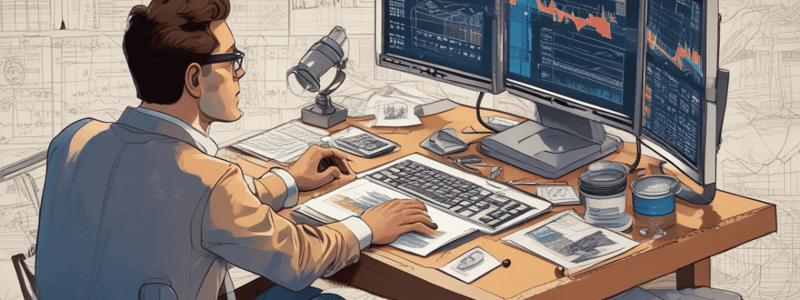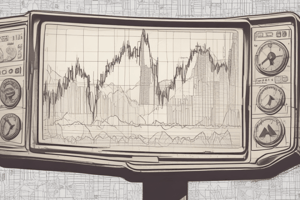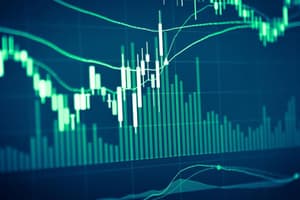Podcast
Questions and Answers
What is the primary assumption underlying the use of price patterns in predicting future price movements?
What is the primary assumption underlying the use of price patterns in predicting future price movements?
- That human psychology and market dynamics are inherently unpredictable.
- That price patterns are solely the result of random chance.
- That human psychology and market dynamics repeat themselves over time. (correct)
- That market trends always move in a linear fashion.
Which type of price pattern suggests that the prevailing trend is likely to continue?
Which type of price pattern suggests that the prevailing trend is likely to continue?
- Reversal pattern
- Continuation pattern (correct)
- Channel pattern
- Symmetrical triangle pattern
What is the typical shape of a pennant pattern?
What is the typical shape of a pennant pattern?
- A zigzag pattern
- A symmetrical triangle (correct)
- A horizontal rectangle
- A channel with a downward slope
What is the characteristic of a flag pattern?
What is the characteristic of a flag pattern?
What is the difference between a rectangle pattern and a pennant?
What is the difference between a rectangle pattern and a pennant?
On which type of charts can price patterns occur?
On which type of charts can price patterns occur?
What is the primary purpose of reversal patterns in technical analysis?
What is the primary purpose of reversal patterns in technical analysis?
What is the significance of the neckline in a Head and Shoulders pattern?
What is the significance of the neckline in a Head and Shoulders pattern?
What is the difference between a Double Top and a Double Bottom pattern?
What is the difference between a Double Top and a Double Bottom pattern?
What is the purpose of using price patterns in conjunction with other technical analysis tools?
What is the purpose of using price patterns in conjunction with other technical analysis tools?
What is the Inverse Head and Shoulders pattern equivalent to?
What is the Inverse Head and Shoulders pattern equivalent to?
Why is it essential to consider other factors in addition to price patterns when trading?
Why is it essential to consider other factors in addition to price patterns when trading?
Flashcards are hidden until you start studying
Study Notes
Price Patterns in Technical Analysis
- Recognizable formations or arrangements of price movements on a chart used to predict future price movements based on human psychology and market dynamics repeating over time.
Classification of Price Patterns
- Classified into two main categories: continuation patterns and reversal patterns, which can occur on various timeframes (intraday charts to long-term charts).
Continuation Patterns
- Suggest that the prevailing trend is likely to continue after the pattern completes.
- Indicate a temporary pause or consolidation within the ongoing trend before the price resumes its prior direction.
- Examples of continuation patterns:
- Flag: Sharp price move (flagpole) followed by consolidation (flag) in the opposite direction of the initial move.
- Pennant: Sharp price move, followed by a period of consolidation that forms a symmetrical triangle.
- Rectangle: Price moves within a horizontal range, forming parallel support and resistance levels, with a breakout confirming trend continuation.
Reversal Patterns
- Indicate a potential change in the prevailing trend, suggesting the current trend is losing momentum and may reverse direction.
- Often occur at key market turning points, providing signals for traders to enter positions in anticipation of a trend reversal.
- Examples of reversal patterns:
- Head and Shoulders: Three peaks with the middle peak (head) higher than the other two (shoulders), signaling a reversal from an uptrend to a downtrend when the neckline is broken.
- Double Top/Double Bottom: Price reaches a significant high or low, retraces, and then revisits the same level, signaling a potential trend reversal.
- Inverse Head and Shoulders: Mirror image of the head and shoulders pattern, signaling a reversal from a downtrend to an uptrend when the neckline is broken.
Using Price Patterns in Trading
- Traders and analysts use price patterns in conjunction with other technical analysis tools to confirm signals and make informed trading decisions.
- Consideration of other factors, such as market conditions, fundamental analysis, and risk management, is essential when trading based on patterns.
Studying That Suits You
Use AI to generate personalized quizzes and flashcards to suit your learning preferences.




